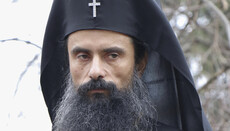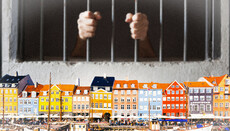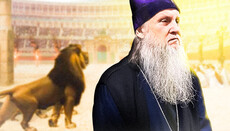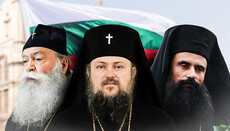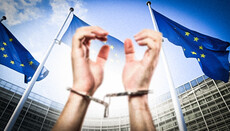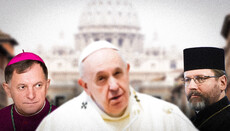Phanar and ethnophyletism: What Pat. Bartholomew is blaming Athonites for
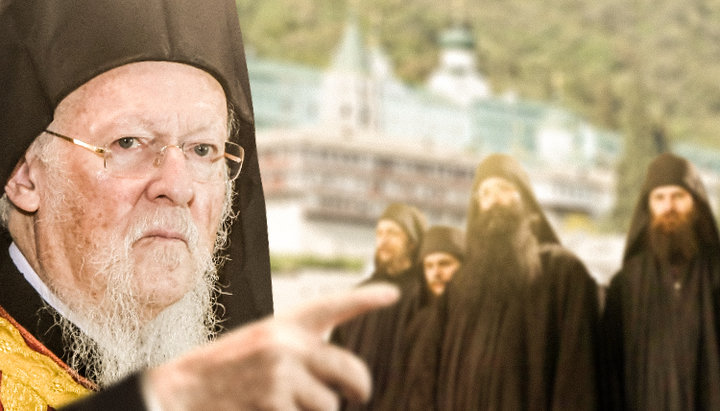
Why the head of the Patriarchate of Constantinople accuses the Russian monks of Athos of what he himself is to blame for.
During a visit to Mount Athos, Patriarch Bartholomew in fact blamed the Russian monks who built one of the largest monasteries on the Holy Mountain for ethnophyletism. Why is he doing this and why is he actually blaming himself in his own words?
On October 21, 2019, Patriarch Bartholomew arrived at St. Andrew’s Skete on Mount Athos and stated that this skete is an example of the Phanar’s struggle to preserve the Holy Mountain from the heresy of ethnophyletism.
For reference: ethnophyletism is when national interests are placed above religious interests and implemented to the detriment of the latter. The local Council of Constantinople in 1872 condemned it as heresy.
“Our Holy Great Church of Christ, under the canonical protection and care of which the Garden of the Virgin Mary (Perivoli tis Panagias) has been for so many centuries, has fought a bloody struggle to protect its independence and shield itself from the heresy of ethnicism, which was in full bloom at that time, and, unfortunately, still is in some circles,” cites his words “Orthodoxia.info”.
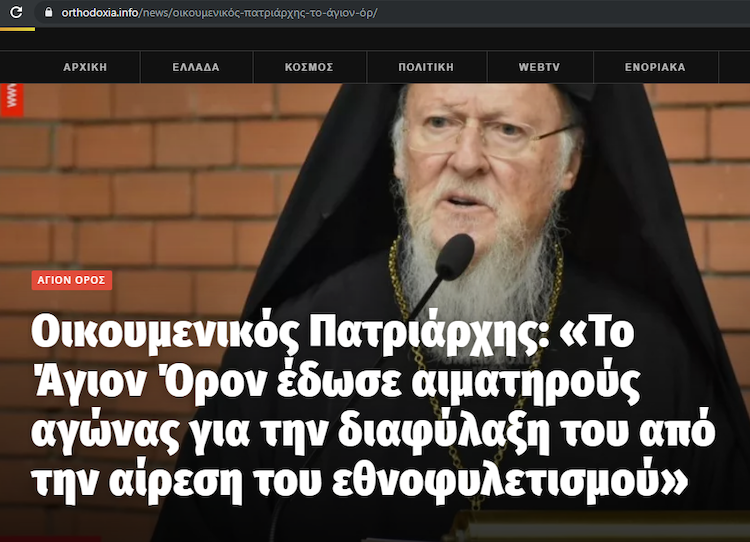
It is not difficult to guess who exactly Patriarch Bartholomew accuses of ethnophyletism. St. Andrew's Skete was built by Russian monks and benefactors. Creating a monastery, decorating it with churches and providing residential and household buildings are, in fact, God’s work. But in the eyes of Patriarch Bartholomew, this, as it turned out, was an attempt to "nationalize" the Holy Mountain.
“It should not be forgotten that the Skete of St. Andrew was a field of conflict of the canonical tradition through the attempt to nationalize Mount Athos and use it as a place of cloaking to serve great ideals and alien for the monastic state goals and pursuits,” Ecumenical Patriarch Bartholomew said.
Let us turn to the history of St. Andrew’s Skete and see when it was a field of battle of the canonical tradition with attempts to nationalize Athos.
The last refuge of patriarchs
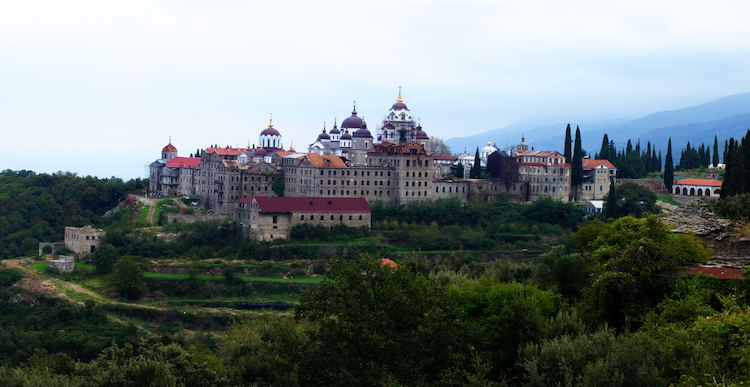
The Skete had its origins when Patriarch Athanasius (Patellarios) of Constantinople retired to Mount Athos in 1651 after the Fall of Constantinople and settled in a Monastic House on the site of the old Monastery of Xistrou that was dedicated to St. Anthony the Great. His personality is so interesting that we cannot but say a few words about him. In our country, he is known as St. Athanasius the Seated, the Wonderworker of Lubny.
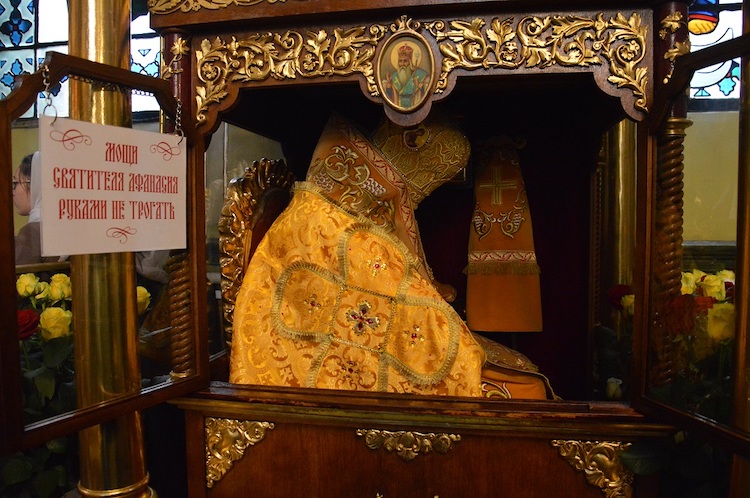
During the Ottoman Empire, Orthodox patriarchs in Constantinople changed very often. This happened by order of the Sultan, who took good money for it.
St. Athanasius was the Patriarch of Constantinople three times – in 1634, 1635 and 1652. And the last two times – just a few days. After the second overthrow from the throne, the Vatican offered him to convert to Catholicism and become a cardinal, but St. Athanasius refused. Again, holding the throne for a short time, St. Athanasius in July 1652 voluntarily renounced from the patriarchate and ad infinitum left Constantinople. He went to Moscow to participate in the editing of liturgical books at the request of Patriarch Nikon of Moscow. There St. Athanasius wrote “The Ordo of the Episcopal Liturgy in the East”, which is still used today.
St. Athanasius’ main reason for his visit to Moscow was to arouse Tsar Alexei Mikhailovich unite with Moldavia and the Cossack Hetmanate for a future war with the Turks, after which the Tsar should become the new Roman Emperor, and the Moscow Patriarch – the new Ecumenical Patriarch.
This idea was not destined to come true, but the very fact of such a proposal is indicative, which shows that the Greek people always deeply cherish hope for the restoration of the Byzantine Empire with its capital in Constantinople and try to use any historic opportunity for this.
During the Ottoman Empire, Orthodox patriarchs in Constantinople changed very often. This happened by order of the Sultan, who took good money for it.
While St. Athanasius was travelling from Moscow to Moldavia, he died en route at the Mgar Monastery near Lubny in 1654. His relics rest in the Kharkov Annunciation Cathedral.
In 1761, another Patriarch of Constantinople, Seraphim II Anina, also retired to Mount Athos and replaced the old cell with a new three-storey building, on the ground floor of which he built the Church of St. Andrew the First-Called and St. Anthony the Great, and on the first floor – the Church of the Intercession of the Most Holy Theotokos. During the Russian-Turkish war of 1768-74, he supported Russia and called on the Greeks to rebel against the Turkish yoke. The uprising was suppressed, and Patriarch Seraphim retired to the same Mgar Monastery, where he died in 1779.
The largest skete
After the death of Patriarch Seraphim, his archdeacon, who remained to maintain the cell of St. Anthony the Great, moved to the Vatopedi Monastery and granted to it all the rights to the cell. Vatopedi did not use the cell and gradually it fell into the state of neglect.
The skete acquired its present-day appearance in the late 19th century. In 1841, it was bought by two Russian monks – Bessarion (Tolmachev) and Barsanouphios (Vavilov). They gathered about 20 Russian monks in it and arranged a skete dormitory. With its expansion, in 1849, the cell officially received the status of a skete, and the Vatopedi Monastery granted the new skete the right to elect its hegumen and have a skete seal.
Bessarion (Tolmachev), the first hegumen of St. Andrew’s Skete, received from Patriarch Anthim IV of Constantinople a letter for the “eternal establishment of the new Russian skete”.
Due to the efforts of Russian monks and the care of Russian philanthropists, St. Andrew's Skete surpasses many Athonite monasteries in size, and its main church – St. Andrew’’s Cathedral – became one of the largest in the East of those built under Turkish rule.
The skete owned significant agricultural land, had its own metochions in Constantinople, Thessaloniki, Odessa, Rostov-on-Don, and St. Petersburg. It published the monthly magazine “Instructions and Consolations of the Holy Christian Faith” and conducted extensive missionary work. By 1906, the number of the brothers laboring the skete reached 500 people.
Due to the efforts of Russian monks and the care of Russian philanthropists, St. Andrew's Skete surpasses many Athonite monasteries in size.
After the 1917 revolution, St. Andrew’s Skete lost all of its property in Russia and the support of philanthropists. Pilgrims and those wishing to serve God in a monastic rank stopped coming to the skete. But the fire of 1958, which raged for three days and in which almost all the buildings and temples burned, made the worst blow. The library and the archive, which totaled about 20,000 books and manuscripts, perished in the fire.
The last Russian hegumen of the skete, Archimandrite Michael died in 1962. After him, only five elderly brothers remained in the skete. Soon they also departed to the Lord. For about 20 years, the once majestic and one of the most numerous sketes of Athos stood completely abandoned and neglected. Later Greek monks gradually settled in it. Despite the fact that they settled arbitrarily, the Russian Orthodox Church never raised the question of the return of the skete to Russian monks. And in 1992, the skete was officially recognized as a Greek shrine.
Does anyone see in this story an attempt to “nationalize the Holy Mountain”? Does anyone see an attempt to "use it as a place of cloaking to serve great ideals and alien for the monastic state goals and pursuits"? Why is the existence of Greek monasteries on Athos not called "nationalization"? Why is the existence of the Bulgarian Zograf Monastery, the Serbian Hilandar Monastery, the Romanian Prodromos Monastery not called “nationalization”?
First in Orthodoxy
Patriarch Bartholomew, accusing others of ethnophyletism, actually exposes the Patriarchate of Constantinople itself.
Statements by the Phanar hierarchs and clergy, including, unfortunately, the representatives of Athos, about the superiority of the Greek nation and its primacy among the Orthodox peoples are very numerous. Here are some examples.
Metropolitan Chrysostom of Zakynthos in his article “Two main dangers” pointed out that Catholicism and “Slavs and Slavic Orthodox Churches under the auspices of the Russian Patriarchate” threaten the Greek nation:
“If the Slavic peoples forgot that the Greeks gave them culture and that they received the light of the Christian faith from the Christian lamp of Greek Byzantium through Greek missionaries, and that therefore they should give their thanks and due respect and favor of the Greek race, which educated and enlightened them, and not manifest themselves as low and ungrateful enemies, then the pan-Orthodox consciousness will sweep away their gloomy and treacherous plans.”
It turns out that there is a great Greek race and second-rate non-Greek peoples who should serve this race and obediently fulfill its wise orders. This article was written back in 1947, and since then, apparently, has become a guide for present-day Phanariots.
In 2018, after the ROC broke off communion with Constantinople Patriarchate in response to the lawless and non-canonical decisions on Ukraine, Patriarch Bartholomew said: “Our brothers Slavs cannot tolerate the primacy of the Ecumenical Patriarchate and our people in Orthodoxy.” Thus, he openly declared the primacy of the Greeks in Orthodoxy.
Judging by the statements of the Phanar hierarchs, there is a great Greek race and second-rate non-Greek nations who should serve this race and obediently fulfill its wise orders.
On February 11, 2019, at a meeting of the Holy Kinot of the Holy Mountain on the “Ukrainian issue”, the representatives of the monasteries who supported the Phanar declared: “Hellenism and the Ecumenical Patriarchate have primacy in Orthodoxy”, as well as: “As Athonites, we won’t tolerate anyone humiliating Hellenism and the Ecumenical Patriarchate."
These and many other similar statements eloquently testify not only to ethnophyletism, not just to the dominance of the national over the religious, but also to the ideology of the superiority of the Greek race over other nations. But the Gospel says the exact opposite, it claims that in Christ “there is no difference between Jew and Gentile—the same Lord is Lord of all and richly blesses all who call on Him” (Rom. 10, 11-12), that in Christ “there is no Gentile or Jew, circumcised or uncircumcised, barbarian, Scythian, slave or free, but Christ is all, and is in all” (Col. 3, 11).
Is the Phanar all and in all?
And finally, why Patriarch Bartholomew raised the topic of ethnophyletism and blamed others for it.
The Phanar, trying to push through his lawless decisions on the “Ukrainian issue”, trying to convince the Local Churches to recognize the OCU created by him, is waging a very subtle informational and diplomatic war. It is trying to present the split that has already taken place in the Orthodox Church as a split along ethnic lines. That, they say, the Russian Orthodox Church and other Slavic Local Churches do not accept the decisions of Constantinople not because they contradict the canons but because they oppose the Greeks, they want to affirm their Slavic superiority in Orthodoxy. Consequently, the Greek Local Churches must consolidate around the Phanar and rebuff.
It is interesting that the Slavic Churches themselves have never claimed for primacy, they have never called themselves that. Moreover, this identification does not apply to the Russian Church, which cares for Christians of many nationalities, from Europeans to Japanese.
In fact, with the recognition of the OCU by the Church of Greece, the schism in Orthodoxy, took place according to the criterion of the recognition or non-recognition of Constantinople as the head of the Orthodox Church rather than the national criterion.
Making decisions on the "Ukrainian issue", the Phanar:
- recognized the ordination of schismatics to be grace-filled;
- joined them to the Church without repentance and even without hearing their appeal (consideration of the appeal involves a certain process with the obligatory hearing of the opinions of the parties, in this case the Moscow Patriarchate and Filaret Denisenko, but this did not take place);
- took away the Kiev Metropolis of 1686 without any, even formal, intercourse on this issue with the Moscow Patriarchate and the UOC;
- granted autocephaly to a group of schismatics located on the canonical territory of another Local Church.
There are no theological and canonical justifications for these decisions. The holy canons allow the Patriarchs of Constantinople to accept appeals only from the clergy of their Church and give autocephaly only to those church structures that are members of the Patriarchate of Constantinople. The recognition of the "ordinations" of Epiphany Dumenko and his "episcopate" as grace-filled is generally beyond Orthodoxy.
One can accept the Phanar’s anti-canonical decisions only in one case – recognizing the supremacy of Constantinople in the entire Orthodoxy. This is the criterion the split is based on.
In its communiqué following the results of the Bishops’ Council, the Greek Church couldn’t cite a single sane, from the point of view of canons, argument for the recognition of the OCU. All reasoning boiled down to the fact that the Patriarchate of Constantinople was right because it was the Patriarchate of Constantinople and had the right to do so. If any Local Church recognizes the OCU, it will follow the path of further recognition of the primacy of Constantinople.
One can accept the Phanar’s anti-canonical decisions only in one case – recognizing the supremacy of Constantinople in the entire Orthodoxy. This is the criterion the split is based on.
The Churches which do not agree with this do not declare that in this situation the Russian Orthodox Church is right. These Churches simply propose to solve the “Ukrainian issue” in a conciliar way. Therefore, division in Orthodoxy takes place precisely on the question: Does the Church have a visible head in the person of the Patriarchate of Constantinople, or does it recognize the direct primacy in the Church of our Lord Jesus Christ?
This can be worded somewhat differently: is the Council or the Patriarchate of Constantinople the highest visible authority in the Church? And since in the Creed we confess: “I believe in the One, Holy, Catholic and Apostolic Church”, the choice is the following: Orthodoxy or the supremacy of the Patriarchate of Constantinople.
Instead, the Phanar hierarchs, headed by Patriarch Bartholomew, are artificially trying to impose on everyone a different, completely false choice: Greek or Slavic (Russian if you want) superiority. That is why Patriarch Bartholomew so hard exploits the theme of ethnophyletism and supposedly the confrontation of the Greeks and Slavs on Mount Athos and in the world as a whole.
Our task is to understand all this and not allow the Slavs to be set up against the Greeks, and the Greeks – against the Slavs, not to fall into the trap set for us and not accept a false concept in which Orthodoxy happens to be Greek, Russian or some other kind. Prevent us from having again Hellenes, Jews, barbarians, Scythians, etc. Have a firm belief that “all and in all is Christ” (Col. 3, 11).
